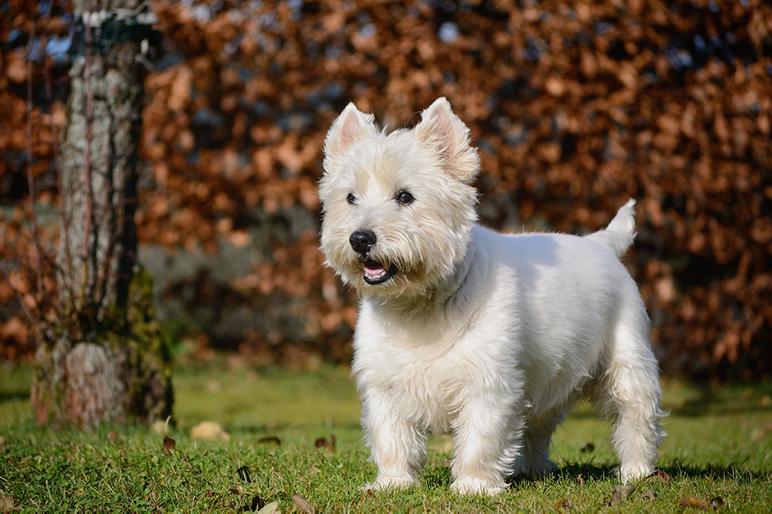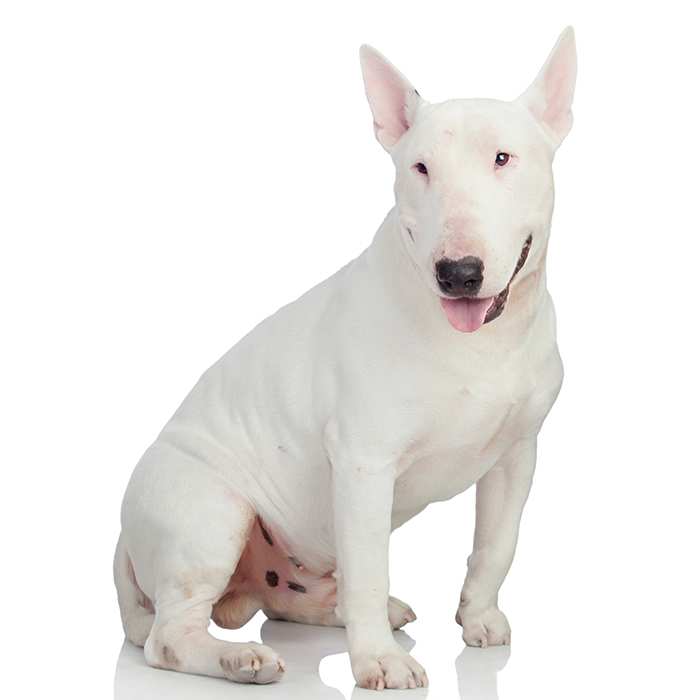West Highland White Terrier


| Recommended for | Active households, families with older children |
| Breed Classification | Terrier group |
| Other names | Westie |
| Lifespan | 12 to 16 years |
| Size | Small |
| Temperament | Friendly, confident, affectionate, stubborn |
| Intelligence | High; independent thinker |
| Tendency to bark | Moderate to high; alert and vocal when excited or as a watchdog |
| Maintenance Level | Low – medium |
| Health Risk | This breed has an around average probability of having health issues in its lifetime, hence it is one of the more affordable breeds to insure. |
Insuring a West Highland White Terrier?
Get our award-winning Nose-to-Tail Cover with up to $30k annual benefit limit, up to 90% of eligible vet bills back, and no sub-limits.
Get a quick quote
Is this breed right for you?
Try our breed selector quiz to find out your best matching breed!
Insuring a West Highland White Terrier?
Get our award-winning Nose-to-Tail Cover with up to $30k annual benefit limit, up to 90% of eligible vet bills back, and no sub-limits.
Get a quick quote
Breed history of West Highland White Terriers
The West Highland White Terrier, known affectionately as the Westie, is a small dog breed originating in Scotland, probably descended from other Scottish terriers such as the Cairn Terrier, the Dandie Dinmont Terrier, the Scottish Terrier and the Skye Terrier. It was bred as a working dog, particularly to retrieve small game animals and to hunt small vermin on farms.
Its distinctive white coat was selectively developed for visibility in the field. According to lore, Colonel Edward Malcolm of Poltalloch was hunting with his brown terriers when he mistook his favourite for a fox and shot it. To avoid this from happening again, Malcolm set out to breed a white terrier that could not be confused with game.
The first recorded pair of Westies arrived in Melbourne, Australia in 1869, imported by the Mackkinnon family. They were reportedly from original stock from the Isle of Skye and were kept pure within the Mackinnon family for 60 years prior to official classification.
More recently, the Westie has experienced increased popularity in Australia thanks to a number of well-known brands using the breed in their advertising campaigns.

Physical description of West Highland White Terriers
The West Highland White Terrier is a small, compact breed with a sturdy and well-proportioned build suited for its original role as a hunting terrier. It has dark, deep-set almond-shaped eyes and small, erect ears that give it an alert and confident look. Its tail is short, straight, and carried high, adding to its confident stance.
Its harsh, straight outer coat and soft undercoat provide protection against harsh weather and rough terrain. Even though pure white is the only colour accepted by kennel clubs, a small number of Westies are wheat coloured or white with darker paws.
| Weight range | 6 to 10 kg |
| Height range | 25 to 30 cm |
| Colours | Pure white |
| Coat length | Medium, with a harsh outer coat and a dense, soft undercoat |

West Highland White Terrier personality and temperament
West Highland White Terriers are confident, adaptable, and affectionate dogs with a lively personality and strong sense of independence. Despite their small size, they have a bold and adventurous nature and always eager to explore and engage with their surroundings.
Highly social and people-oriented, Westies form deep bonds with their family and enjoy being at the centre of household activities. They thrive in an environment where they receives plenty of attention, mental stimulation, and playtime, making them a great choice for active families. Daily walks, interactive games, and puzzle toys help keep them engaged and prevent boredom. While they are playful and full of energy, they also enjoy moments of relaxation and affection, making them well-balanced companions.
Westies are highly intelligent, quick learners, and responsive to training, though their independent streak may require consistent and patient guidance. They are naturally curious and alert, traits that make them excellent watchdogs. They adapt well to various living situations, from city apartments to suburban homes, as long as their exercise needs are met. Though social by nature, Westies are also independent-minded and capable of entertaining themselves when left alone for short periods.

West Highland White Terriers with kids and other pets
The West Highland White Terrier is a lively and affectionate breed that makes a wonderful family companion, especially in homes with older children (above 7 years). Sturdy and playful, Westies enjoy interactive activities and can form strong bonds with kids who treat them respectfully. Their friendly and confident nature makes them fun playmates, though supervision is recommended with younger children since they have been known to snap if irritated. While affectionate, Westies also have an independent streak, so early training and ongoing supervision can help reinforce good manners and positive interactions with all family members.
Westies generally get along well with other dogs, but their strong prey drive may lead them to chase smaller pets like cats or rabbits. Early socialisation and training are essential to help them coexist peacefully with other animals. They can adapt to the company of cats, though it is recommended that they are raised with the cat rather than introducing it later in the dog’s life.

West Highland White Terrier training and exercise
West Highland White Terriers are energetic and intelligent dogs that require daily exercise and mental stimulation to stay happy and well-behaved. Despite their small size, Westies have a strong, active nature and enjoy activities like walks, interactive play, and agility training. Engaging them in games such as fetch or scent work can help satisfy their natural curiosity and high energy levels. Without regular activity, including a daily walk, they may become restless or develop undesirable behaviours.
Westies form strong bonds with their families and enjoy being actively involved in household activities. While they have an independent streak, they thrive in environments where they receive attention and interaction. They are not suited to being left alone for extended periods, as they may become bored and resort to excessive barking or mischief. Providing mental challenges, such as puzzle toys and obedience training, helps keep them engaged and prevents frustration.
Westies are highly trainable, but they require firm and consistent guidance to manage their independent spirit. They respond best to positive reinforcement methods, such as treats and praise, rather than harsh corrections. Early socialisation is essential to help them develop into well-mannered companions, especially around other pets and new experiences.
| Energy level | High |
| Exercise requirements | High |

West Highland White Terrier feeding and nutrition
As an active and energetic breed, Westies require a well-balanced diet rich in high-quality protein, healthy fats, and essential vitamins to support their muscular build, coat health, and immune system. Their food should be tailored to their size, age, and activity level to ensure they receive the right nutrients for sustained energy and optimal health.
As Westies age, their dietary needs evolve. Puppies need nutrient-dense food to support rapid growth and development, while adults benefit from balanced meals that provide energy without leading to excess weight gain. Senior Westies may require lower-calorie food with joint-supporting supplements to maintain mobility and overall health. Adjusting their diet based on age and lifestyle can help prevent common issues like obesity and digestive sensitivities.
Managing calorie intake is crucial, as excess weight can put strain on their joints and lead to other health concerns. Portion control, regular mealtimes, and monitoring their weight help prevent obesity-related issues. Routine veterinary check-ups are important for assessing their overall health and addressing any nutritional concerns early.

West Highland White Terrier care and grooming
West Highland White Terriers have a distinctive double coat, featuring a harsh, wiry outer layer and a soft, dense undercoat. This coat protects them from harsh weather and rough terrain but requires regular grooming to maintain its texture and keep them looking their best. Weekly brushing helps remove loose hair, prevent matting, and maintain a clean and healthy coat. They do not shed much and because of this are thought of as being mostly hypoallergenic.
Unlike some other breeds, Westies should not be shaved or clipped short, as this can damage their coat’s natural texture and protective properties. Instead, they benefit from occasional hand-stripping, a technique that removes dead hair and helps maintain their signature neat coat. Regular trimming around the paws, ears, and face keeps them looking tidy while preserving their classic Westie appearance.
Westies do not require excessive bathing, but an occasional bath every few months or when they get particularly dirty will help keep their fur fresh and bright. Nail trimming should be done routinely to prevent overgrowth, which can cause discomfort or mobility issues. Their ears should be checked and cleaned regularly to avoid infections, as their fur can trap moisture and debris. Dental care is equally important, as small breeds like Westies can be prone to dental issues. Regular teeth brushing or professional cleanings will help maintain good oral health and prevent tartar buildup..
Health issues for West Highland White Terriers
- Hip Dysplasia, although not as common in small breeds, can still affect Westies. This condition involves improper development of the hip joint, leading to pain, stiffness, and potential arthritis over time. Maintaining a healthy weight, providing joint-supportive nutrition, and engaging in moderate exercise can help manage symptoms and improve mobility.
- Hypothyroidism, a condition where the thyroid gland underproduces hormones, can occur in West Highland White Terriers. Symptoms include weight gain, lethargy, skin and coat changes, and intolerance to cold. This condition is manageable with lifelong medication and a carefully monitored diet to regulate hormone levels.
- Progressive Retinal Atrophy (PRA) is a genetic eye disorder that leads to progressive vision loss and eventual blindness. While there is no cure, regular eye exams and genetic testing in breeding programs can help reduce its incidence.
- Craniomandibular Osteopathy, sometimes referred to as “Westie jaw”, is a condition which affects a growing pup’s skull, causing it to become enlarged. Possibly inherited, symptoms usually begin to show around 4 to 8 months of age and include swelling of the jaw and glands and inability to open the mouth. There is no cure, but anti-inflammatory medications may help control the pain and a proper diet is essential. The irregular bone growth typically stops when the dog reaches the age of one year. Lesions may disappear, but some dogs can have permanent jaw damage and may require surgery.
- Pulmonary Fibrosis, also known as “Westie lung disease”, is a condition that affects the lung’s air sacs and connective tissue, making them lose their elasticity and preventing oxygen entering the blood properly. Symptoms include lethargy, rapid breathing, coughing and difficulty breathing. It may also lead to heart failure and other serious diseases and there is no cure. Some dogs may find cooler temperatures and bronchial dilators helpful. Since the prognosis for affected dogs is usually quite poor, prevention is essential. This includes maintaining a healthy weight, preventing respiratory infections and minimising exercise.
- Dental Disease is common in many small breeds, and Westies are susceptible to dental issues, including tartar buildup, gum disease, and tooth loss. Regular brushing, dental chews, and professional cleanings are essential to maintain their oral health and prevent serious infections.
- Allergies can occur in Westies, who are known for having sensitive skin and can develop allergies to food, pollen, or environmental irritants. Symptoms include itching, redness, and excessive licking or scratching. Managing allergies may involve dietary adjustments, medicated shampoos, or allergy treatments prescribed by a vet.
Not all conditions are covered by Pet Insurance. For details of Bow Wow Meow Pet Insurance cover, refer to the Product Disclosure Statement.
Thinking about insuring a West Highland White Terrier
Thinking about insuring a West Highland White Terrier
Learn moreThinking about insuring a West Highland White Terrier
Learn moreFree engraved pet ID tag on sign up3
Customer Satisfaction
21 day cooling off
Easy to use Pet Portal

GapOnly® in vet claims
MORE INFORMATION
The West Highland White Terrier Club of NSW: http://www.westieclubofnsw.org.au/
West Highland White Terrier Club of Victoria: http://www.westieclubvic.org.au/





